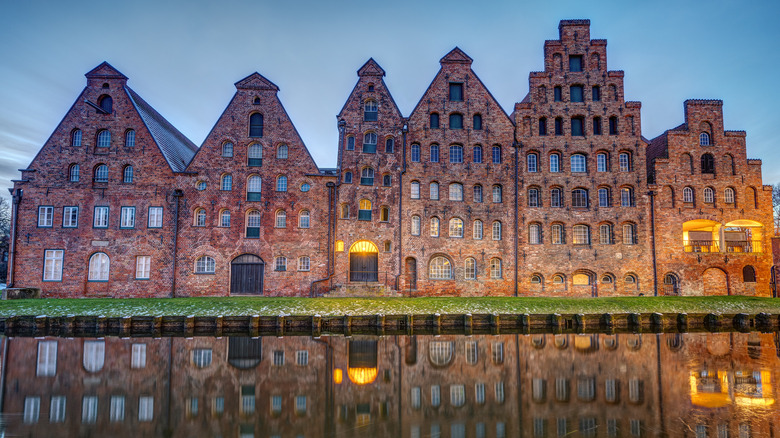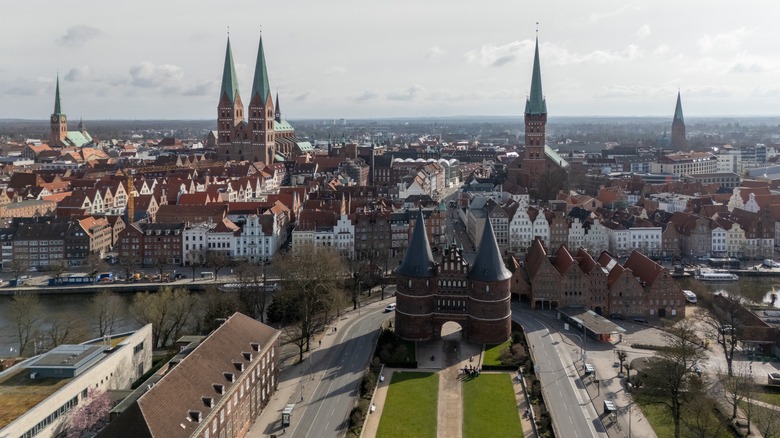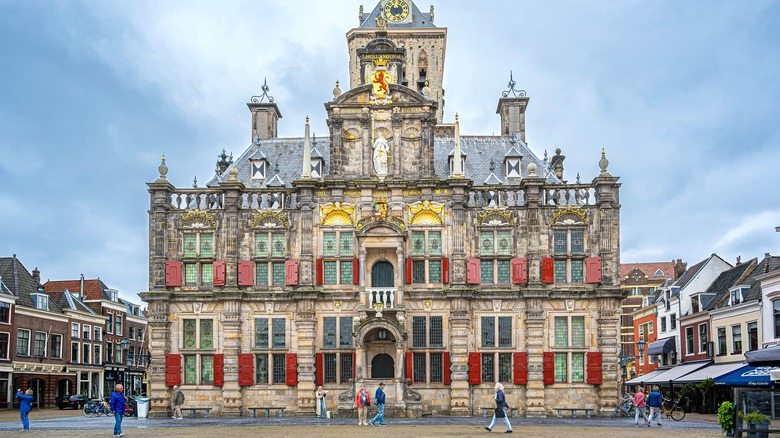Horror Movie Fans May Get Nosferatu Nostalgia In This European City Full Of Historic Charm
The city of Lübeck, Germany, is a UNESCO World Heritage Site that once reigned as the capital of the Hanseatic League, a powerful trade organization in northern Europe. Since its founding in 1143, Lübeck has retained its medieval appearance with Gothic brick church towers, for which it's nicknamed the "city of the seven spires." After kicking around for almost 900 years, it's practically old enough to be a vampire now. That's not an idle comparison, either, since Lübeck's main historic appeal to set-jetters (travelers seeking out movie locations) may be its onscreen role in the 1922 silent vampire film, "Nosferatu."
Instead of sailing into London like his literary inspiration, Dracula, the monstrous Count Orlok brings his plague ship to the town of Wisborg, Germany, in "Nosferatu." Wisborg is a fictional composite, shot mainly in two real-life German cities. As a German descendant who's written extensively about vampire movies, including "Nosferatu" and its remakes, I was curious to track down those places, along with iconic filming locations in Görlitz, Germany. That's what first led me to Lübeck.
Perhaps the most recognizable landmark from Lübeck that shows up in "Nosferatu" is the Salzspeicher, a jagged row of six salt storehouses along the Trave River. In the movie, Count Orlok totes his coffin into the Salzspeicher and makes it his lair, gazing out from its windows as he encroaches on human civilization. You'll see the Salzspeicher as you cross the bridge right after the famous Holsten Gate, one of three passages into Lübeck, back when it was a walled city. The gate has appeared on German coins and old deutsche mark bills. It also appears in almond cake form down the street at the Holstenstrasse branch of Cafe Niederegger, which sells the local specialty of marzipan.
Lübeck's churches lead to another Hanseatic city
The seven spires that give Lübeck its nickname include two pairs of twin towers. Each pair connects to a centuries-old Lutheran church that stands over 360 feet tall. Lübeck Cathedral and St. Mary's Church (or Marienkirche, in German) both occupy the dense medieval Old Town (Altstadt) on the city's central island. The taller St. Mary's, under renovation until 2031, has broken bells on the floor inside — the remnant of a World War II bombing. Its spiky brick Gothic architecture was highly influential in the Baltic Sea region.
Lübeck's smallest major church, St. Giles (Aegidienkirche), lent its yard to the exterior shots of Thomas Hutter's home in "Nosferatu." St. Peter's Church has a viewing platform where you can take in the city's skyline, which continues to influence Wisborg's cinematic look, as seen in the 2024 "Nosferatu" remake. Other local spots shown in the 1922 film include the Füchtingshof (the alley where Hutter strolled home) and the Depenau (the street where pallbearers carried a line of coffins).
As it turns out, Lübeck isn't the only Hanseatic city and world heritage site where "Nosferatu" was filmed. Head to Wismar, just 90 minutes away by train, and you'll find more real-world echoes of the movie's visuals. Wismar has its own St. Mary's Church, though it was badly damaged during a World War II air raid. Only the tower remains, but you can see that tower (with a spire that's no longer there) overlooking Wismar's marketplace in the opening shot of "Nosferatu." On the city's cobblestone streets, there are film-reel plaques that flag shooting locations like the marketplace and the Wassertor ("water gate"). An establishing shot of the harbor also greeted Count Orlok's ship on its arrival in Wisborg.
The vampire hunt continues outside Germany
Today, black-and-white images of Lübeck and Wismar aren't the only ones movie-loving travelers might associate with "Nosferatu." Director F.W. Murnau's unauthorized "Dracula" adaptation — itself a masterpiece of German expressionist cinema — has since spawned two critically well-regarded, color remakes. In the 1979 version, director Werner Herzog renamed Wisborg after the real-life city that inspired it, Wismar. This was before the Berlin Wall fell, and Herzog was a leading West German filmmaker. Rather than venture into East Germany, where Wismar was located at the time, he opted to film the city of Delft in the Netherlands as a stand-in.
Travel host Rick Steves calls Delft an "idyllic mini-Amsterdam," but its town square and city hall served as the backdrop for the apocalyptic plague party in Herzog's "Nosferatu." To bring Dracula's castle to life for that version, the filmmaker shot on location at Pernštejn Castle in the Czech Republic. Director Robert Eggers returned to the same location to film the castle courtyard scenes for his 2024 remake. The castle's exterior, however, was pure Transylvania in the Eggers version. It was captured at Corvin Castle, one of the best places to stop on a road trip through Transylvania.
In a 2025 interview with CN Traveler, production designer Craig Lathrop said the fictional Wisborg was "a collage of places" in Eggers' "Nosferatu." The same could be said of it in Murnau's original silent film, which stitched together two German cities to create an impression of one doomed to a vampire plague. Over 100 years later, Lathrop pointed to Lübeck and its architectural features as his biggest overall influence. As you pass through its gate and gaze up at its church spires, the city makes an excellent starting point for a "Nosferatu"-inspired tour of Europe.


